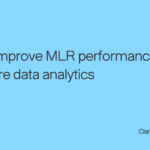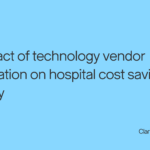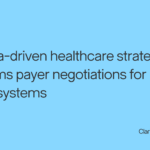This is part two of our three-part series about how health plan leaders can leverage healthcare claims data to reduce costs, strategically grow their networks, provide best-in-class member services, and enhance outcomes for their members. In the era of digital transformation, healthcare claims data stands out as a critical asset health plans can use to optimize their network performance. As value-based care models become the prevailing standard among leading-edge healthcare providers, payers must meet the moment with data-driven decision-making. Healthcare organizations can harness the power of claims data to boost service delivery and operational efficiency, improve patient outcomes, attract and retain members, and drive strategic growth. Here are eight ways healthcare claims can be used to optimize network performance. Optimizing network performance with healthcare claims data begins with a detailed analysis of provider performance. Healthcare claims data offer extensive insights into providers’ efficiency and quality of care. Metrics like treatment outcomes, patient follow-up rates, and cost-effectiveness signal high-performing providers who provide high-quality, cost-effective healthcare. And a reputation for excellence perennially appeals to current and prospective members. Identifying the best practices of exceptional providers enables healthcare payers to incentivize improvements among all providers in their networks. Rewarding superior service fosters a competitive, quality-driven environment. Effective and comprehensive healthcare network design is crucial to its effectiveness and accessibility. By analyzing claims data, payers can better understand the specific health needs and preferences of their member populations. This understanding facilitates networks that offer comprehensive care that’s tailored to meet patients’ needs. When a network features a balanced mix of specialties and services that align with members’ demands, it can optimize resource allocation and enhance member satisfaction. This alignment is also a strategy that can minimize gaps in care. Ensuring that each geographic area the network serves has adequate access to healthcare is a boon for payers as well as underserved patients. Providing excellent service while maintaining operational efficiency is a delicate balance. One of the best ways to do both well is to predict future healthcare demands by analyzing historical claims data. The trends and patterns in healthcare utilization provide valuable insights that help payers anticipate changes in patients’ needs and make adjustments accordingly. That’s how healthcare networks can stay prepared without overextending their capacity. Accurate forecasting also helps networks with optimizing strategic planning. Claims data is the best basis for justifying network expansions and enhancements. Contract negotiations between payers and providers are cornerstones of financial sustainability and quality for both parties. The evidence-based insights that healthcare claims provide can strengthen healthcare networks’ negotiating positions — because they can leverage this detailed cost and performance data. Fair pricing structures, including performance-based incentives, are straightforward inclusions in contracts. But healthcare claims data doesn’t just promote financial equity; it also encourages providers to continuously improve quality of care. When healthcare organizations align provider incentives with broader health outcomes, everyone wins. Service gaps in healthcare networks can significantly hinder members’ access to healthcare. These gaps may arise in rural areas and neighborhoods with historically underserved communities. Service gaps may also be due to limited access to transportation in aging populations or a relative lack of specialists in certain regions. Claims data can identify these gaps by highlighting areas with inadequate services. Healthcare organizations can strategically recruit providers to fill these gaps, enhancing their coverage and ensuring members have the access they need. This data-driven approach also helps networks tailor their offerings to community-specific needs, ensuring that all members receive equitable, quality healthcare regardless of location. Not all providers deliver care to the same standard. To maintain network quality, it is vital for health plans to identify providers whose outcomes are not up to par. Claims data lets organizations discern which providers or facilities fall below quality metrics. Healthcare plans can collaborate with providers to help them adopt industry best practices and advanced technologies — which enhances the overall quality of care within the network and strengthens its reputation (a critical element of attracting and retaining members). Effective utilization management leads to cost savings that can be redirected towards other critical areas within the healthcare system, such as investing in innovative technologies, enhancing patient care services, or expanding access to preventive health programs. Reinvestments like these further enhance patient care outcomes and network performance. Plus, when patients believe their healthcare services are both necessary and beneficial, they gain more trust in the healthcare system overall. That trust itself can lead to greater patient satisfaction. What’s more, patients who appreciate their healthcare plan are more likely to engage in their own wellness. They also tend to be more loyal to their healthcare providers, which also improves health outcomes.. Service utilization management is an often-overlooked part of network optimization. Healthcare claims data analysis can identify patterns of over-utilization like unnecessary imaging or lab tests. Networks can set clinical guidelines and utilization benchmarks to help ensure that healthcare services are necessary and suited to the patient, avoiding wasteful spending. Diligent management of resources reduces costs and minimizes patient exposure to unnecessary procedures which are proven to boost patient safety and satisfaction. Fostering collaboration among healthcare providers via integrated care models is another element of optimizing network performance. These healthcare claims-data-supported models encourage coordination between primary care providers, specialists, nurses, and other clinicians. By promoting this collaborative approach, payers can help providers reduce redundancies, speed up patient care processes, and improve their members’ overall health outcomes. When a patient’s healthcare providers are all on the same page regarding plans for their treatment, the healthcare experience is more seamless and efficient. Supporting this kind of collaboration also helps in breaking down silos within the healthcare system. Because collaborative care models enable healthcare professionals to coordinate care across different specialties and services, they help eliminate duplicative efforts and reduce the chances of conflicting treatments. These models also typically involve shared health records and communication platforms. A comprehensive view of a patient’s medical history is a game changer for providers, who can make better-informed decisions about patient care. Healthcare claims data is much more than just billing records writ large. It’s a key that unlocks the potential of healthcare networks. When payers and providers both are more efficient, cost-effective, and responsive to patients’ needs, members are healthier — and happier with their healthcare plans. Claims data analytics is also a tool for strategic growth. As technology continues to transform our healthcare system, the ability to analyze and visualize claims data will be an absolute necessity. Healthcare claims data enables provider performance analysis
Claims enrich network design optimization
Healthcare claims data analytics facilitate demand forecasting
Claims data promotes painless contract negotiations
Analyzing healthcare claims improves access to care
Scrutinizing healthcare claims leads to better utilization management
Claims analysis empowers collaborative care models
Claims data, healthcare, and decoding the future
- Author Details





